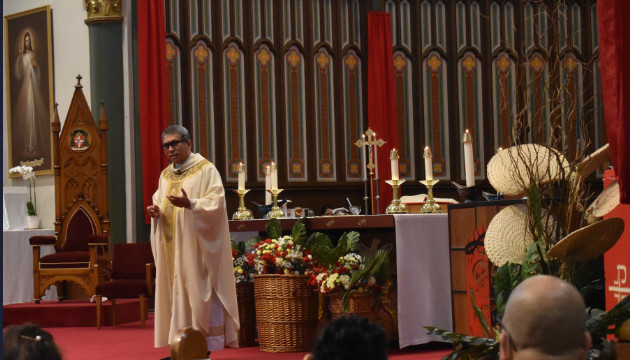Parishioners attending the 5 p.m. mass at Saint Andrew’s Cathedral in Victoria, British Columbia, on June 12, 2022 must have thought, on stepping inside the Cathedral doors, that they were in a foreign country.
Parishioners working as ushers, greeting and guiding mass attendees, were in different Filipino attires - the men in barong shirts, the women in barong dresses or in floor-length gowns with butterfly sleeves (called terno). The altar itself was decorated with baskets filled with flowers, and framed by an arrangement of woven fans. The choir, too, was in costume!
The mass was a culminating ceremony for the year-long observance of 500 years of Christianity in the Philippines. Most mass attendees wore Filipino formal attire barong and terno or ensembles with tribal motifs.
 Members of the Victoria Catholic community bring in an image of the beloved Sto. Nino.
Members of the Victoria Catholic community bring in an image of the beloved Sto. Nino.
The June 12 mass was celebrated through Katesismong Pinoy, a group that meets regularly to discuss uniquely Philippine perspectives on the Bible and the Catholic faith. The group, and Filipino Catholics in Victoria, are fortunate to have a Filipino “shepherd” in Fr. Dino Villadiego who celebrated the special Filipino-themed mass and currently serves as Rector of Saint Andrew’s Cathedral. He was supported by an all-Filipino cast of altar servers, a deacon and eucharistic ministers.
Apart from the beautiful outfits of church ushers and choir members and the Filipino theme in the altar decorations, churchgoers were treated to a visual feast of Philippine religious symbols. At Offertory, Filipino parishioners in native costume brought in a boat, a small image of the Infant Jesus of Prague (affectionately called the Santo Nino in the Philippines), an earthenware jar, a basket of fruits, a bamboo plant, a mosquito net, rice in a glass container and large rosary beads.
The boat represented the arrival of Spanish colonizers in the Philippines with the discovery of the islands by Ferdinand Magellan in 1521. The Santo Nino represented the introduction of the Catholic faith in the Philippines. The earthenware jar and the water it contained symbolized Filipinos’ adaptability and ability to survive. The basket of fruits served as a reminder that current generations are enjoying the fruits of past generations’ labour; the bamboo represented Filipinos’ strength and flexibility; a mosquito net served as a symbol of the protection prayer gives to families; rice was the staple food of Filipinos and the blessings they enjoy; and the rosary beads served as a symbol of Filipinos’ faith and love for the Virgin Mary.
Fr. Dino, in his homily, said that the faith of Filipinos is hard won. From the time of Spanish colonization, their faith has been tested by many factors, has survived, and is therefore worth celebrating. A particularly moving part of the mass was when the Prayers of the Faithful was said in six major languages of the Philippines: Bikol, Ilocano, Kapampangan, Tagalog, Cebuano, and Hiligaynon.
Filipinos who served as volunteers for various church duties received a special blessing at the end of the mass. On leaving the church, churchgoers were treated to complimentary pan de sal, donated by the El Shaddai group. Filipinos and non-Filipinos alike found the mass a moving testimony to Filipinos’ faith and love for the church.



